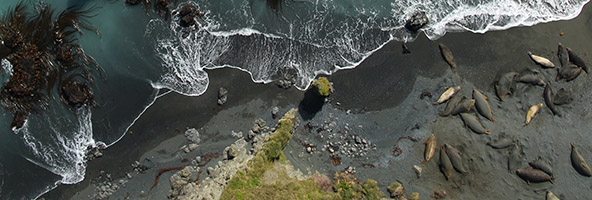Media Release: Call to minimise drone impact on wildlife
ŨîÐÂĖĮÐÄVlog of Adelaide environmental researchers have called for a ââ in using unmanned aerial vehicles (drones) for wildlife monitoring and protection, and other biological field research.

The researchers, from the ŨîÐÂĖĮÐÄVlogâs or Adelaide Drone Hub, say that drones are a useful tool for field research and their use is growing in popularity.
But, they warn in a report published in the Cell Press journal , this new technology could also have undesirable and unforeseen impacts on wildlife and there is currently little understanding of the risks.
The report authors are , researcher and PhD candidate in the URAF, and , Director of URAF and a global pioneer in the use of drones for conservation as founding director of the not-for-profit organisation .
âEven though an animal might not appear to be disturbed, it could be quite stressed â for example, a bird may choose to remain near a UAV even when stressed because it is incubating an egg or protecting its hatchling,â says Mr Hodgson. âIt is likely that animal responses vary depending on a variety of factors including the species, environmental and historical context, as well as the type of UAV and its method of operation.â
Mr Hodgson says that considering the growing popularity of UAVs as a tool among field biologists, and the potential for negative impacts on wildlife, steps need to be taken to minimise and manage the risk.
âA code of best practice will allow informed use of UAVs, while mitigating or alleviating potential wildlife disturbance,â he says.
Mr Hodgson and Associate Professor Koh provide a suite of recommendations as the basis for such a code of best practice for using drones in the vicinity of animals and/or for the purpose of animal research.
They consider this code should be a first and guiding step in the development of species specific protocols to reduce potential disturbance to wildlife.
Their recommendations cover:
- adopting a precautionary principle in lieu of evidence
- utilising institutional animal ethics processes to provide oversight
- complying with civil aviation regulations; regular maintenance and training
- selecting appropriate UAVs for the job
- exercising minimum wildlife disturbance flight practices, and ceasing operations if they are disruptive
- publishing detailed reports of methods and results.
âIn a time of unprecedented change, such techniques will assist in understanding, managing and conserving our planetâs biodiversity; and maximise the potential of UAVs as a powerful, low impact ecological survey tool,â Mr Hodgson says.
Jarrod Hodgson, lead author.
Mobile: +61 (0) 427 506 152, jarrod.hodgson@adelaide.edu.au
Robyn Mills, Media Officer.
Phone: +61 8 8313 6314 Mobile: +61 (0)410 689 084, robyn.mills@adelaide.edu.au

The researchers, from the ŨîÐÂĖĮÐÄVlogâs or Adelaide Drone Hub, say that drones are a useful tool for field research and their use is growing in popularity.
But, they warn in a report published in the Cell Press journal , this new technology could also have undesirable and unforeseen impacts on wildlife and there is currently little understanding of the risks.
The report authors are , researcher and PhD candidate in the URAF, and , Director of URAF and a global pioneer in the use of drones for conservation as founding director of the not-for-profit organisation .
âEven though an animal might not appear to be disturbed, it could be quite stressed â for example, a bird may choose to remain near a UAV even when stressed because it is incubating an egg or protecting its hatchling,â says Mr Hodgson. âIt is likely that animal responses vary depending on a variety of factors including the species, environmental and historical context, as well as the type of UAV and its method of operation.â
Mr Hodgson says that considering the growing popularity of UAVs as a tool among field biologists, and the potential for negative impacts on wildlife, steps need to be taken to minimise and manage the risk.
âA code of best practice will allow informed use of UAVs, while mitigating or alleviating potential wildlife disturbance,â he says.
Mr Hodgson and Associate Professor Koh provide a suite of recommendations as the basis for such a code of best practice for using drones in the vicinity of animals and/or for the purpose of animal research.
They consider this code should be a first and guiding step in the development of species specific protocols to reduce potential disturbance to wildlife.
Their recommendations cover:
- adopting a precautionary principle in lieu of evidence
- utilising institutional animal ethics processes to provide oversight
- complying with civil aviation regulations; regular maintenance and training
- selecting appropriate UAVs for the job
- exercising minimum wildlife disturbance flight practices, and ceasing operations if they are disruptive
- publishing detailed reports of methods and results.
âIn a time of unprecedented change, such techniques will assist in understanding, managing and conserving our planetâs biodiversity; and maximise the potential of UAVs as a powerful, low impact ecological survey tool,â Mr Hodgson says.
Jarrod Hodgson, lead author.
Mobile: +61 (0) 427 506 152, jarrod.hodgson@adelaide.edu.au
Robyn Mills, Media Officer.
Phone: +61 8 8313 6314 Mobile: +61 (0)410 689 084, robyn.mills@adelaide.edu.au

Newsletter & social media
Join us for a sensational mix of news, events and research at the Environment Institute. Find out aboutĖýnew initiatives andĖýshare with your friends what's happening.
ĖýĖýĖý
